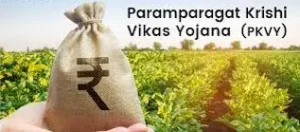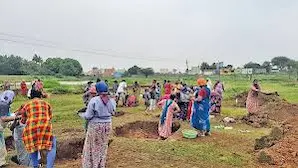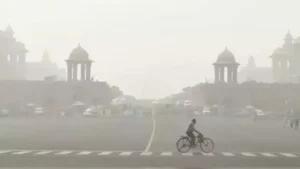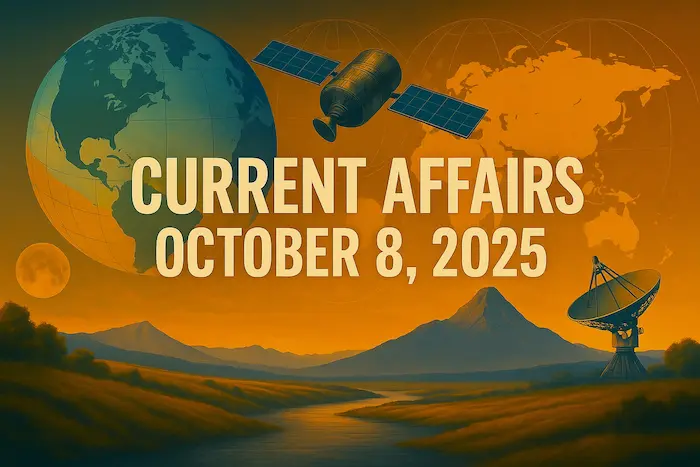1.10 Years of Paramparagat Krishi Vikas Yojana (PKVY) – Economy

Why in News?
PKVY marks a decade of implementation (2015–2025).
Transitioned from a pilot cluster model into a national framework focused on:
Training of organic farmers
Certification systems
Market access and linkages for organic produce
Objectives of PKVY
To promote organic and traditional chemical-free farming.
To reduce dependence on synthetic inputs like fertilizers and pesticides.
To create a sustainable, eco-friendly farming model using traditional Indian knowledge systems.
Key Features of the Scheme
Cluster-Based Model
Farmers form clusters of at least 20 hectares.
Enables resource sharing, joint certification, and group marketing.
Reduces per-farmer cost and enhances efficiency.
Institutional Framework
Implemented by the Ministry of Agriculture & Farmers Welfare
Launched under the National Mission for Sustainable Agriculture (NMSA)
Certification Mechanisms
| System | Description |
|---|---|
| NPOP (National Programme for Organic Production) | 3rd-party certification system for exports and formal markets. |
| PGS-India (Participatory Guarantee System) | Community-based certification model for domestic markets. |
| LAC (Large Area Certification, 2020) | Simplified process for chemically untouched areas, enabling fast certification. |
Digital Integration: Jaivik Kheti Portal
Centralized online platform connecting:
Farmers ↔ Buyers ↔ Input Suppliers
Enhances:
Transparency in trade
Ease of access to organic produce
Market discovery and fair pricing
Achievements (As of January 2025)
₹2,265.86 crore released for promoting organic farming.
15 lakh hectares under organic cultivation.
52,289 clusters established.
25.3 lakh farmers actively involved.
Sikkim achieved 100% organic status.
Expansion to challenging geographies like Ladakh and Nicobar Islands.
Challenges and Issues
| Challenge | Explanation |
|---|---|
| Yield Reduction | Organic transition leads to short-term yield dip, especially affecting small/marginal farmers. |
| Certification Costs | Residue testing and verification remain expensive for many farmers. |
| Market Linkages | Lack of strong price premiums, buyers’ trust, and stable demand. |
| Cluster Variation | Performance depends heavily on local leadership and institutional support. |
| Sustainability | Need for long-term funding, training, and technical support to sustain momentum. |
Important Concept
Paramparagat Krishi Vikas Yojana (PKVY)
PGS-India, NPOP, LAC
Jaivik Kheti Portal
National Mission for Sustainable Agriculture (NMSA)
Cluster-Based Organic Farming
Exam Connect – Possible Questions
Prelims
Which of the following certification systems under PKVY is used primarily for domestic organic markets?
A. NPOP
B. AGMARK
C. PGS-India
D. FSSAI
Answer: C. PGS-IndiaWhich state became the first fully organic state in India under the Paramparagat Krishi Vikas Yojana?
A. Arunachal Pradesh
B. Himachal Pradesh
C. Sikkim
D. Uttarakhand
Answer:C. Sikkim
Mains
1.”Organic farming holds the key to sustainable agricultural development in India, but faces several systemic challenges.” Examine this statement in the context of the Paramparagat Krishi Vikas Yojana (PKVY). (250 words)
2. MGNREGA – Mandatory Allocation for Water Conservation – Governance

Why in News?
The Ministry of Rural Development (MoRD) has amended Schedule-I of the Mahatma Gandhi National Rural Employment Guarantee Act (MGNREGA), 2005, mandating minimum fund allocation for water conservation and harvesting works. This step addresses the growing groundwater crisis and strengthens sustainable rural employment and resource management.
Background: MGNREGA in Brief
Provides 100 days of guaranteed wage employment annually to rural households willing to do unskilled work.
Focus on rural asset creation, poverty alleviation, and climate-resilient infrastructure.
Includes works like water conservation, drought proofing, afforestation, etc.
Key Amendment Details
Schedule-I of MGNREGA (which defines permissible works) amended via government notification (24th amendment since 2005).
New rule mandates block-level minimum spending on water conservation based on groundwater extraction levels.
Groundwater-Based Fund Allocation
Based on the Central Ground Water Board’s 2024 assessment of 6,746 blocks:
| Groundwater Category | Extraction Level | Minimum Allocation for Water Works |
|---|---|---|
| Over-Exploited | >100% | 65% |
| Critical | 90–100% | 65% |
| Semi-Critical | 70–90% | 40% |
| Safe | ≤70% | 30% |
Financial Impact (FY 2025–26):
From ₹86,000 crore MGNREGA budget, ₹35,000 crore is estimated to be spent on water-related works.
Key beneficiary states: Rajasthan, Punjab, Tamil Nadu — due to high number of stressed groundwater blocks.
Significance of the Amendment
For Rural Areas
Creates climate-resilient assets.
Enhances employment in rural water infrastructure.
Promotes community-based water management.
For Governance & Sustainability
Supports:
Jal Shakti Abhiyan
Atal Bhujal Yojana
Promotes integrated planning, natural resource regeneration, and local accountability.
Way Forward
Integrated Planning
Align with:
PM Krishi Sinchayi Yojana (PMKSY)
Watershed Development Programs
Capacity Building
Train Gram Sabhas, engineers, and PRI functionaries in water budgeting and sustainable works.
Tech-Driven Monitoring
GIS mapping
Real-time dashboards
Geo-tagged asset tracking
Sustainability Focus
Develop check dams, percolation tanks, plantation drives, and soil moisture conservation structures.
Key Concepts
MGNREGA Schedule-I
Groundwater categorization by CGWB
Jal Shakti Abhiyan, Atal Bhujal Yojana
PMKSY, Watershed Development
Gram Sabha role in decentralized planning
Exam Connect – Possible Questions
Prelims
1. Which of the following correctly matches the groundwater category and its corresponding minimum fund allocation under MGNREGA’s amended Schedule-I?
A. Over-exploited – 40%
B. Semi-critical – 65%
C. Critical – 65%
D. Safe – 65%
Answer: C. Critical – 65%
2. The 2025 amendment to MGNREGA mandates minimum fund allocation to water conservation projects based on:
A. Average annual rainfall
B. Surface water availability
C. Groundwater extraction levels by CGWB
D. Soil fertility data from ICAR
Answer: C. Groundwater extraction levels by CGWB
Mains
1.”The amendment to MGNREGA linking employment to water conservation marks a strategic shift in India’s rural development policy.” Discuss how this policy convergence can address environmental and socio-economic challenges in rural India. (250 words)
2. Examine the role of Panchayati Raj Institutions (PRIs) in implementing water conservation projects under MGNREGA. How can capacity building improve their effectiveness? (150 words)
3. Jal Jeevan Mission – Asset Mapping on PM Gati Shakti Portal – Governance

Why in News?
The Union Government has announced that all drinking water assets, including pipelines under the Jal Jeevan Mission (JJM), will be mapped on the PM Gati Shakti portal, a GIS-based platform designed to enhance infrastructure planning and inter-ministerial coordination.
About Jal Jeevan Mission (JJM)
Launch Date:
August 15, 2019
Nodal Ministry:
Ministry of Jal Shakti
Mission Objective:
To provide safe and adequate piped drinking water to every rural household in India by 2024, on a household tap connection basis.
Key Components of JJM
Infrastructure Development
In-village piped water supply systems to ensure Functional Household Tap Connections (FHTCs).
Community-Led Planning
Bottom-up approach involving local communities in:
Planning
Implementation
Operation & Maintenance (O&M)
Empowerment of Women
Women-led Water Committees (Village Water & Sanitation Committees – VWSCs) participate in:
Monitoring water quality
Managing water sources
Decision-making
Focus on Institutions
Provision of tap water in:
Schools
Anganwadi centers
Tribal hostels
Capacity Building & Skill Development
Training of local youth for:
Plumbing
Pump operation
Water quality testing
Sustainability Measures
Groundwater recharge
Greywater management (reuse and recycling of wastewater)
Water conservation techniques
Ensuring long-term water source security
Funding Pattern of JJM
| Region Type | Centre:State Funding Ratio |
|---|---|
| General States | 50:50 |
| Himalayan & North-Eastern States | 90:10 |
| Union Territories | 100% Central Funding |
New Development: GIS Mapping on PM Gati Shakti Portal
The mission will use Geographic Information System (GIS) to map:
Pipelines
Tanks
Pump houses
Water treatment plants
Benefits of GIS Mapping:
Transparent asset management
Real-time monitoring of infrastructure
Avoids duplication across departments
Enhances infrastructure planning efficiency
Key Concepts
Jal Jeevan Mission (JJM)
PM Gati Shakti portal – GIS-based national infrastructure planning platform
Greywater management
Village Water & Sanitation Committees (VWSCs)
Functional Household Tap Connections (FHTCs)
JJM funding pattern by region
Exam Connect – Possible Questions
Prelims
1. Which of the following features is NOT a component of the Jal Jeevan Mission?
A. Greywater management
B. In-village piped water supply
C. Urban wastewater treatment plants
D. Community-based monitoring
Answer: C. Urban wastewater treatment plants
2. What is the funding ratio between Centre and States for Jal Jeevan Mission in North-Eastern and Himalayan states?
A. 50:50
B. 75:25
C. 90:10
D. 100:0
Answer: C. 90:10
Mains
1.”Jal Jeevan Mission reflects a paradigm shift in India’s approach to rural water governance.”
Discuss how the mission ensures sustainability, community ownership, and equitable access to water. (250 words)
2. Examine the role of digital platforms like PM Gati Shakti in enhancing transparency and efficiency in the implementation of infrastructure schemes like Jal Jeevan Mission. (150 words)
4. Decoding Delhi’s Air Pollution – The Role of the Decision Support System (DSS) – Environment

Why in News?
As Delhi enters its winter air pollution season, the Decision Support System (DSS) for Air Quality Management has been reactivated.
Developed by the Indian Institute of Tropical Meteorology (IITM), Pune, DSS:
Identifies and quantifies daily source contributions to air pollution (PM2.5 and PM10).
Forecasts pollution levels and simulates impact of mitigation measures.
Understanding the Decision Support System (DSS)
What is DSS?
A numerical modeling platform to monitor, analyze, and predict air quality.
Designed to assist policymakers in crafting targeted pollution control measures.
How It Works
Operates on a 10-km resolution grid for the National Capital Region (NCR).
Provides:
5-day air quality forecasts
Sector-wise contributions: vehicles, industry, residential sources, stubble burning, dust, etc.
Simulation of emission control scenarios
Current Limitation
Runs only during winter, despite year-round pollution.
Uses a 2021 emissions inventory, which may undermine accuracy.
IITM is currently updating the inventory.
Key Takeaways from DSS (October 2025)
Transport Emissions – Primary Contributor
Largest source of PM2.5 and PM10 in Delhi.
Residential emissions: ~4–5%
Industrial emissions: ~3–5%
Farm Fires – Minimal Contribution (So Far)
On October 5: 0.22% contribution to PM2.5
On October 6: 0% contribution
Data based on VIIRS satellite monitoring
However, stubble burning expected to increase in coming weeks.
Temporary Relief from Rains
Recent rain and wind events lowered pollution levels temporarily.
Experts caution pollution will worsen with:
Falling temperatures
Calm wind conditions
Increased biomass burning in Punjab and Haryana
Significance of DSS for Delhi’s Air Quality Management
| Aspect | Significance |
|---|---|
| Source-specific insights | Helps differentiate between urban vs rural sources (transport vs stubble). |
| Forecast-based planning | Enables authorities to take pre-emptive action before pollution spikes. |
| Simulation of policy options | Evaluates how certain measures (like vehicle bans) can affect AQI levels. |
| GIS-based analysis | Allows spatial mapping of pollution hotspots for targeted response. |
Challenges & Limitations
Outdated Emissions Data (2021) – affects model accuracy.
Seasonal Operation – DSS is only active in winter months.
Limited Real-Time Data Integration – currently relies more on static inventories.
Need for Continuous Monitoring – to understand pollution dynamics throughout the year.
Important Concepts
Decision Support System (DSS)
PM2.5 vs PM10 – Fine vs coarse particulate matter
Indian Institute of Tropical Meteorology (IITM), Pune
VIIRS Satellite – Tracks fire and thermal anomalies
Air Quality Index (AQI)
Source Apportionment Studies
Exam Connect – Possible Questions
Prelims
1. The Decision Support System (DSS) for air quality management in Delhi was developed by:
A. Central Pollution Control Board
B. Indian Meteorological Department
C. Indian Institute of Tropical Meteorology (IITM), Pune
D. National Environmental Engineering Research Institute (NEERI)
Answer: C. Indian Institute of Tropical Meteorology (IITM), Pune
2. According to the DSS data, which of the following is currently the largest contributor to Delhi’s PM2.5 pollution?
A. Stubble Burning
B. Residential Cooking
C. Transport Emissions
D. Industrial Emissions
Answer: C. Transport Emissions
Mains
1.”Delhi’s air pollution problem is as much about urban emissions as it is about regional coordination.” Discuss how the Decision Support System (DSS) helps policymakers distinguish between local and external pollution sources. (250 words)
2. Discuss the importance of real-time emissions data in urban air quality forecasting. How can tools like the DSS be improved for better policy responses? (150 words)
5. Reforming Passive Euthanasia in India -Governance

Why in News?
The U.K.’s proposed Terminally Ill Adults (End of Life) Bill seeks to legalize physician-assisted dying for mentally competent adults with less than six months to live, pending approval from the House of Lords.
This development has reignited debate in India, which currently allows only passive euthanasia and prohibits active euthanasia.
The Indian government is considering reforms to simplify and digitize the passive euthanasia process.
Understanding Euthanasia in India
Passive Euthanasia (Allowed)
Involves withdrawing life support or withholding medical treatment to allow a patient to die naturally.
Legally recognized under the Supreme Court’s landmark judgment in:
Aruna Shanbaug Case (2011) – Introduced passive euthanasia conditionally
Common Cause v. Union of India (2018) – Legalized passive euthanasia with safeguards
Requires:
Advance Directive (Living Will)
Verification by two medical boards
Judicial oversight
Active Euthanasia (Not Allowed)
Involves deliberate action to end life, e.g., administering lethal drugs.
Remains illegal and ethically contested in India.
Challenges in the Current Framework
| Challenge | Explanation |
|---|---|
| Complex Procedures | Advance directives require notarization, medical board approval, and court intervention. |
| Legal Ambiguity | Informal decisions by families can place doctors at legal risk. |
| Lack of Awareness | Patients and families are unaware of their legal rights and process. |
| Institutional Weaknesses | Few hospitals have active ethics committees or trained palliative teams. |
Proposed Reforms in India
Digital Facilitation
Create a national portal for managing Advance Directives, linked with Aadhaar.
Improves accessibility, authentication, and record-keeping.
Hospital-Level Empowerment
Authorize hospital ethics committees (instead of courts) to oversee withdrawal of life support.
This would decentralize decision-making while retaining accountability.
Safeguards to Prevent Misuse
Retain:
7-day cooling-off period
Mandatory psychological counselling
Evaluation by palliative care experts
Key Concepts
Passive vs Active Euthanasia
Advance Directive / Living Will
Aruna Shanbaug Case (2011)
Common Cause v. Union of India (2018)
Hospital Ethics Committees
Palliative Care
Exam Connect – Possible Questions
Prelims
1. What is the legal status of passive euthanasia in India?
A. It is illegal in all forms
B. Allowed only through court orders in each case
C. Legal under specified guidelines issued by the Supreme Court
D. Legal only for minors and mentally ill patients
Answer: C. Legal under specified guidelines issued by the Supreme Court
2. Which of the following is true about an Advance Directive in India?
A. It is registered in district courts only.
B. It is valid only for minors.
C. It allows a person to express their wish to refuse life support in specific conditions.
D. It is permitted only in foreign jurisdictions.
Answer: C. It allows a person to express their wish to refuse life support in specific conditions.
Mains
1.”The recognition of passive euthanasia in India marked a significant milestone in end-of-life care, but its implementation remains limited.” Critically examine the legal and ethical challenges associated with euthanasia in India. (250 words)
2. Discuss the role of digital governance in enhancing access to end-of-life care through reforms in passive euthanasia policy. (150 words)
6. Criticism of the Indian Judiciary – Misplaced Blame or Structural Challenge? – Polity

Why in News?
Recent public commentary by prominent policymakers has criticized the judiciary for allegedly hindering India’s progress toward becoming a developed nation.
These remarks, however, oversimplify complex governance failures and misrepresent the judiciary’s role in a constitutional democracy.
The issue has reignited debates on the institutional health, workload, and funding of the Indian judicial system.
Key Takeaways
Judiciary as Scapegoat
The blame game often shifts attention from:
Inefficient governance mechanisms
Poorly drafted legislation
Critics ignore the constitutional duty of courts to review executive action, not to impede development.
Major Issues with the Current Narrative
Misattribution of Blame
Example:
The failure of pre-suit mediation under the Commercial Courts Act, 2015 is a legislative design flaw, not judicial inaction.
Government as the Biggest Litigant
The government accounts for nearly 50% of pending cases.
Frivolous litigation, avoidable appeals, and administrative disputes clog the judicial pipeline.
Judicial Workload Misunderstood
Judges handle 50–100 cases per day.
Judgment writing, case reading, and research happen beyond courtroom hours.
Vacations are used for writing judgments, not leisure, as commonly portrayed.
Structural Challenges Facing Judiciary
| Issue | Impact |
|---|---|
| Underfunding of Courts | Inadequate infrastructure, especially at the district court level. |
| Vacancy of Judges | Leads to delays, especially in high-volume trial courts. |
| Poor Law Drafting | Ambiguity leads to increased litigation and legal complexity. |
| Inefficient Processes | Lack of digitization and automation delays judicial outcomes. |
Understanding the Role of Judiciary in a Democracy
Guardian of the Constitution – Enforces fundamental rights and checks arbitrary governance.
Judicial Review – Holds laws and executive actions accountable.
Balance of Power – Ensures that the executive and legislature do not exceed their constitutional boundaries.
Key Concepts
Commercial Courts Act, 2015
Judicial Review vs Judicial Overreach
Separation of Powers – Article 50
Judicial Vacancies and Pendency Rates
Role of Government Litigation
E-courts and Judicial Digitization Projects
Exam Connect – Possible Questions
Prelims
1. Which of the following is a key contributor to judicial backlog in India, as identified in recent judicial reforms discourse?
A. Judicial vacations
B. Citizens filing too many RTIs
C. Government being the largest litigant
D. Supreme Court handling traffic violation cases
Answer: C. Government being the largest litigant
2. The doctrine of separation of powers in India is:
A. Strictly followed like in the U.S.
B. Not part of the Constitution
C. Mentioned in Article 50 and implied in the basic structure
D. Abolished through constitutional amendment
Answer: C. Mentioned in Article 50 and implied in the basic structure
Mains
1.“The Indian judiciary is often blamed for governance failures, but the real issue lies in systemic inefficiencies.”
Critically analyze this statement in the context of judicial delays and institutional challenges. (250 words)
2.Discuss how underfunding and poor legislative design contribute to the challenges faced by the Indian judiciary. What reforms are needed to strengthen the justice delivery system? (150 words)

